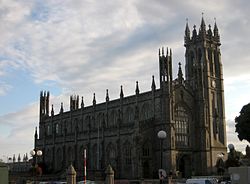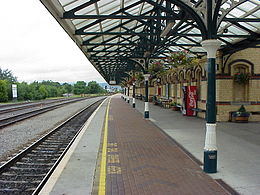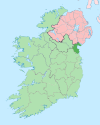- Dundalk
-
This article is about the town of Dundalk in Ireland. For other uses, see Dundalk (disambiguation)
Dundalk
Dún Dealgan— Town — Clanbrassil Street, the main thoroughfare of Dundalk 
Coat of armsMotto: Mé do rug Cú Chulainn cróga (Irish)
"I gave birth to brave Cú Chulainn"Location in Ireland Coordinates: 54°00′32″N 6°24′18″W / 54.009°N 6.4049°WCoordinates: 54°00′32″N 6°24′18″W / 54.009°N 6.4049°W Country Ireland Province Leinster County County Louth Dáil Éireann Louth EU Parliament East Area[1] - Town 24.68 km2 (9.5 sq mi) Population (Census 2011) - Rank 7th - Urban 31,073 - Rural 25,581 - CSA 56,654 Irish Grid Reference J048074 Dialing code 042, +353 42 Website dundalk.ie Dundalk (from Irish: Dún Dealgan meaning "Dalgan's stronghold") is the county town of County Louth in Ireland. It is situated where the Castletown River flows into Dundalk Bay. The town is close to the border with Northern Ireland and equi-distant from Dublin and Belfast. The town's name, which was historically written as Dundalgan,[2] has associations with the mythical warrior Cú Chulainn. The town's crest reads Mé do rug Cú Chulainn Cróga, meaning "I gave birth to brave Cú Chulainn". It was granted its charter in 1189. Within legally defined boundaries it is the largest town in Ireland (pop. 31,073).[3] It is also the largest by area.[4] Dundalk's rural population is 25,581 giving a combined statistical area of 56,654.[3]
In 2003, Dundalk was amongst nine cities and towns to be designated Gateway status in the Irish Government's National Spatial Strategy.[5]Contents
History
The Dundalk area has been inhabited since at least 3500 BC, when Neolithic farmers first came to Ireland. A tangible reminder of their presence can still be seen in the form of the Proleek Dolmen, the eroded remains of a megalithic tomb located at Ballymascanlon a few miles to the north of Dundalk. Celtic culture arrived in Ireland around 500 BC, having colonised most of Europe. The group that settled in North Louth were known as the Conaille Muirtheimhne and took their name from Conaill Carnagh, legendary chief of the Red Branch Knights of Ulster. Their land now forms upper and lower Dundalk. The poets in Celtic society were known as the fili and were responsible for mythological tales and legends, the most famous being the tales of the Red Branch Knights, the Táin Bó Cuailgne and Cúchulainn.
Dundalk had been originally developed as an unwalled Sráid Bhaile (meaning village; translates literally as "Street Townland"). The streets passed along a gravel ridge which runs from the present day Bridge Street in the North, through Church Street to Clanbrassil Street to Earl Street, and finally to Dublin Street.
In 1169, the Normans arrived in Ireland and set about conquering large areas. By 1185 a Norman nobleman named Bertram de Verdun erected a manor house at Castletown Mount and subsequently obtained the town's charter in 1189. Another Norman family, the De Courcys, led by John de Courcy, settled in the Seatown area of Dundalk, the "Nova Villa de Dundalke". Both families assisted in the fortification of the town, building walls and other fortification in the style of a Norman fortress. The town of Dundalk was developed as it lay close to an easy bridging point over the Castletown River and as a frontier town on the northern extremities of the Pale. In 1236 Bertram’s granddaughter, Rohesia commissioned Castle Roche to fortify the region, and to offer protection from the Irish territory of Ulster.
Further, the town was sacked in 1315, during the Bruce campaign.
Historical populations Year Pop. ±% 1821 9,256 — 1831 10,078 +8.9% 1841 10,782 +7.0% 1851 9,842 −8.7% 1861 10,360 +5.3% 1871 11,327 +9.3% 1881 11,913 +5.2% 1891 12,449 +4.5% 1901 13,076 +5.0% 1911 13,128 +0.4% 1926 13,996 +6.6% 1936 14,684 +4.9% 1946 18,562 +26.4% 1951 19,678 +6.0% 1956 21,687 +10.2% 1961 21,228 −2.1% 1966 21,678 +2.1% 1971 23,816 +9.9% 1981 29,135 +22.3% 1986 30,608 +5.1% 1991 30,061 −1.8% 1996 30,195 +0.4% 2002 32,505 +7.7% 2006 35,090 +8.0% [6][7][8][9][10] The modern town of Dundalk largely owes its form to Lord Limerick (later James Hamilton, 1st Earl of Clanbrassil) in the 17th century. He was responsible for the construction of streets leading to the town centre; his ideas came from many visits to Europe. In addition to the demolition of the old walls and castles, he had new roads laid out eastwards of the principal streets. The most important of these new roads connected a newly laid down Market Square, which still survives, with a linen and cambric factory at its eastern end, adjacent to what was once an army cavalry and artillery barracks (now Aiken Military Barracks).
In the 19th century, the town grew in importance and many industries were set up in the local area. This development was helped considerably by the opening of railways, the expansion of the docks area or 'Quay' and the setting up of a board of commissioners to run the town.
The partition of Ireland in May 1921 turned Dundalk into a border town and the Dublin–Belfast main line into an international railway. The Irish Free State opened customs and immigration facilities at Dundalk to check goods and passengers crossing the border by train. The Irish Civil War of 1922-23 saw a number of confrontations in Dundalk. The local Fourth Northern Division of the Irish Republican Army under Frank Aiken tried to stay neutral but 300 of them were arrested by the new Irish Army in August 1922. However, a raid on the barrack freed Aiken and two weeks later he took Dundalk barracks and captured its garrison before freeing the remaining republican prisoners there. Aiken did not try to hold the town, however, and before withdrawing he called for a truce in a meeting in the centre of Dundalk.
For several decades after the end of the Civil War, Dundalk continued to function as a market town, a regional centre, and a centre of administration and manufacturing. Its position close to the border gave it considerable significance during the "Troubles" of Northern Ireland. Many people were sympathetic to the cause of the Provisional Irish Republican Army and Sinn Féin. It was in this period that Dundalk earned the nickname 'El Paso', after the Texan border town of the same name on the border with Mexico.
Dundalk suffered economically when Irish membership of the European Economic Community in the 1970s exposed local manufacturers to foreign competition that they were ill equipped to cope with. The result was the closure of many local factories, resulting in the highest unemployment rate in Leinster, Ireland's richest province. High unemployment produced serious social problems in the town that were only alleviated by the advent of the Celtic Tiger investment boom at the start of the 21st century. Dundalk's economy has developed rapidly since 2000. Today many international companies have factories in Dundalk, from food processing to high-tech computer components. Harp Lager, a beer produced by Diageo, is brewed in the Great Northern Brewery, Dundalk.
Transport
Shipping services to Liverpool were provided from 1837 by the Dundalk Steam Packet Company.
Dundalk is an important stop along the Dublin–Belfast railway line, being the last station on the Irish side of the border. Its rail link to Dublin was inaugurated in 1849 and the line to Belfast was opened the following year. Further railway links opened to Derry by 1859 and Greenore in 1873.
In the 20th century, Dundalk's secondary railway links were closed: first the line to Greenore in 1951 and then that to Derry in 1957. In 1966 Dundalk railway station was renamed Dundalk Clarke Station after the Irish republican activist Tom Clarke, though it is still usually just called Dundalk Station. The station is served by the Dublin-Belfast "Enterprise" express trains as well as local Commuter services to and from Dublin. It also houses a small museum of railway history.
Ongoing infrastructure evolutions continue in and around Dundalk to meet a programme deadline of 2020. These improvements embrace the road, rail and telecommunication infrastructures for—according to the National Development Plan—a better integration with the neighbouring Dublin, Midlands Gateway, and Cavan/Monaghan Hubs.
The M1 - N1/A1 now connects Dundalk to Dublin and Newry. Works to extend it to Belfast are ongoing and are scheduled to end in winter 2010.
Education
Dundalk Institute of Technology (often abbreviated to DkIT) is the primary higher education provider in the North East of the country. It was established in 1970 as the Regional Technical College, offering primarily technician and apprenticeship courses. It has since evolved to become one of the major third level institutions, providing wide ranging full-time and part-time under-graduate and post-graduate courses.
Primary schools
- Gaelscoil Dhún Dealgan,[11]
- S.N Muire na nGael (also known as Bay Estate N.S)
- St. Fursey's National School
- St. Nicholas' National School
- St. Joseph's NS
- St. Oliver Plunkett's NS
- C.B.S. Primary School
- St. Malachy's National School (also known as the Friary)
- De la Salle School
- Dún Dealgan Primary School
- Faughart N.S
- Castletown Girls School
- Scoil Eoin Baiste
- Realt na Mara Primary School
- Darver N.S., Readypenny
Secondary schools
- Dundalk Grammar School
- De la Salle College
- St. Mary's College
- O'Fiaich College
- Coláiste Rís
- St. Vincent's Secondary School
- St. Louis Secondary School
- Bush, Cooley
Sport
Dundalk has a long and proud history of sport with Dundalk F.C. and Dundalk R.F.C.
In recent years Dundalk has seen the development of new sporting facilities including the JJB Soccer Dome and the Dundalk Ice Dome where local ice hockey team the Dundalk Bulls play. The Ice Dome hosted the IIHF World Championship of Division III in April 2007.[12]
Dundalk also has a long horseracing tradition. August 2007 saw Ireland's first all-weather horseracing track open up on the site of the old Dundalk racecourse.[13] The course held Ireland's first ever meeting under floodlights on September 27, 2007. Greyhound racing also takes place at Dundalk Stadium.
Dundalk also held its first ever National Fencing tournament in April 2007.
Dundalk also has a basketball team The Dundalk Ravens.
Dundalk also has a tennis club, the club was founded in 1913 and held the Senior Interprovincial Championschips (inter-pros) on August 29–31, 2010 .[14]
Dundalk Cricket Club was founded in November 2009 and began playing matches in the 2010 season.[15] It achieved the rare distinction of being recognised by the world leading cricket magazine The Wisden Cricketer as its "Club of the Month" for October 2010, this is both unusual for an Irish club and a club only twelve months into its existence. In 2011, the club was admitted into the Leinster Cricket Union and played in Leinster Senior League Division 11. In the 2011 season it won the Leinster League Division 11 Championship title and in the course of doing so became the only club in the whole of Leinster across the 14 divisions to go unbeaten. The club accumulated 277 points overall the highest points of any Leinster club in the 2011 season.
Dundalk & District Snooker League has been running for over 20 years, in 2010 the league was re-branded as the Dundalk Snooker League sponsored by Tool-Fix. The league has grown in popularity over the last few seasons and has attracted national recognition through RIBSA (Republic of Ireland Snooker and Billiards Association) and the CYMS Letterkenny, who have arranged a "ryder cup" style challenge match against the best players in the Dundalk Snooker League. This season the league has 15 teams and 113 players competing in 6 championship events, 4 ranking events and 5 special events, find out more about the Dundalk Snooker League www.dundalksnookerleague.com[16]
Arts
Dundalk has two photography clubs - Dundalk Photographic Society[17] and the Tain Photographic Club. In 2010 Dundalk Photographic Society won the FIAP Photography Club World Cup.[18]
Dundalk has a vibrant music environment. The following can be found:
The Fr.McNally Chamber Orchestra created in April 2010.[19] It is a string chamber orchestra made of violins, violas, double basses and celli and has 29 members.
The Cross Border Orchestra of Ireland [20](CBOI) which is one of Ireland's primary youth orchestras. It is based in the Dundalk Institute of Technology and maintains a membership of 160 young musicians between the ages of 12 and 24 years. The CBOI was established in 1995 shortly after the implementation of the Peace Process and is recognised internationally and one of Ireland's flagship peace initiatives. The CBOI tours regularly to Europe and America and has sold out such prestigious venues as Carnegie Hall, New York and Chicago Symphony Hall.
The Clermont Chorale.[21] It was formed in 2003 and has 30 members, drawn from all parts of County Louth. Its repertoire includes music from the 17th to the 21st century, across many styles and genres.
Dundalk School of Music.[22] Created in February 2010, it aims to provide education in music for all age groups in many disciplines.
People
- Bagatelle Irish Rock Band, Scribed songs like "Summer in Dublin", shared the stage with artists like Bob Marley, Phil Coulter etc.
- Brendan O'Dowda (1925–2002), Irish tenor who popularised the songs of Percy French.
- Cathy Maguire, singer-songwriter. Currently lives in the United States.
- Dawn Martin, Singer who represented Ireland in the 1998 Eurovision concert finishing 9th.
- Dermot Ahern, local solicitor and Fianna Fáil party politician. Formerly Ireland's Minister for Justice.
- Dorothy Macardle (1889–1960), revolutionary, author and playwright.
- Francis Leopold McClintock, arctic explorer, discoverer of the fate of Franklin.
- John Moore, film director, producer, and writer.
- John Phillip Holland, Inventor of the submarine, worked as a teacher in Colaiste Ris, Dundalk.
- Liam Reilly, singer who represented Ireland in the 1990 Eurovision Song Contest finishing 2nd and singer in the group Bagatelle.
- Nicholas Callan, scientist who made the first induction coil went to primary school here.
- Paddy Clarke, President of Irish Professional Photographers Association. (IPPA).
- Patrick McDonnell, actor in Naked Camera and Father Ted.
- Peter Rice (1935-1992). Noted engineer, worked on the Sydney Opera House, Louvre Pyramid and Centre Pompidou as well as numerous other world famous buildings.
- Rob Kearney Rugby player, current player for both Leinster and Ireland.
- Steve Staunton, former football player and former Republic of Ireland national football team manager.
Éamonn Rogers current Irish international archer and multiple national champion lives in Dundalk
- The Corrs, Celtic folk rock group and family, born and raised in Dundalk.
- Thomas Coulter, (1793-1843) botanist and doctor.
- Tom Sharkey, (1873–1953) Heavyweight boxer.
- Tommy Byrne, Former Formula 1 racing driver.
- Tommy Traynor, (1933–2006) former footballer, Republic of Ireland national football team and Southampton FC left-back.
- The Flaws Indie Rock Band.
- Henry McShane, Emigrated to the United States founded the McShane Bell Foundry and named the rail depot and subsequently the town Dundalk, Maryland after his home town in the 19th Century.
Twinning
Dundalk is twinned with the following places:
See also
- List of abbeys and priories in County Louth
- List of towns and villages in Ireland
- Dundalk (Parliament of Ireland constituency), which existed until the Act of Union in 1800
- Dundalk (UK Parliament constituency), which existed 1801-1885
References
- ^ "Table 6 - Population and area of each Province, County, City, urban area, rural area and Electoral Division, 2011 and 2006" (PDF). Census 2011, Volume 1 - Population Classified by Area. Central Statistics Office. 2011-06-20. pp. 70. http://www.cso.ie/census/Table8.htm. Retrieved 2011-06-30.
- ^ Placenames Database of Ireland
- ^ a b Census 2011
- ^ Census (area) 2011
- ^ Irish Spatial Strategy
- ^ Census for post 1821 figures.
- ^ http://www.histpop.org
- ^ http://www.nisranew.nisra.gov.uk/census
- ^ Lee, JJ (1981). "On the accuracy of the Pre-famine Irish censuses". In Goldstrom, J. M.; Clarkson, L. A.. Irish Population, Economy, and Society: Essays in Honour of the Late K. H. Connell. Oxford, England: Clarendon Press.
- ^ Mokyr, Joel; O Grada, Cormac (November). "New Developments in Irish Population History, 1700-1850". The Economic History Review 37 (4): 473–488. doi:10.1111/j.1468-0289.1984.tb00344.x. http://www3.interscience.wiley.com/journal/120035880/abstract.
- ^ [1] Gaelscoil Dhún Dealgan
- ^ IIHF - Div 3 Match reports
- ^ RTE - 2007 Irish Racing
- ^ [2]
- ^ [3]
- ^ [4]
- ^ Dundalk Photographic Society website
- ^ FIAP 5th Club World Cup Results Page
- ^ Fr.McNally Chamber Orchestra
- ^ The Cross Border Orchestra of Ireland
- ^ The Clermont Chorale
- ^ Dundalk School of Music
- ^ Dundalk - Reze twinning page
External links
- DundalkLive.ie - Events guide, community portal and business directory
- Dundalk Chamber of Commerce
- Dundalk Town Council
- Architecture of Dundalk
- Dundalk Stadium - Greyhound and Horse Racing
- Dundalk Ice Dome
- Dundalk.ie
- Town Centre Commercial Manager
- Louth County Museum in Dundalk
- Louth Hospital in Dundalk
- Dundalk FC
- Dundalk Institute of Technology
- St Mary's college
- Dundalk Port
- Dundalk Photographic Society
Places in County Louth County town: DundalkTowns Ardee · Carlingford · Castlebellingham · Clogherhead · Drogheda · Dundalk
Villages and
TownlandsAnnagassan · Ballymascanlan · Baltray · Blackrock · Collon · Dromiskin · Dunleer · Greenore · Jenkinstown · Knockbridge · Louth · Omeath · Stonetown · Tallanstown · Termonfeckin · Tullyallen
List of townlands in County Louth · Category:Mountains and hills of County Louth · Category:Rivers of County Louth · Category:Geography of County LouthCategories:- Dundalk
- County towns in the Republic of Ireland
- Port cities and towns in the Republic of Ireland
Wikimedia Foundation. 2010.







